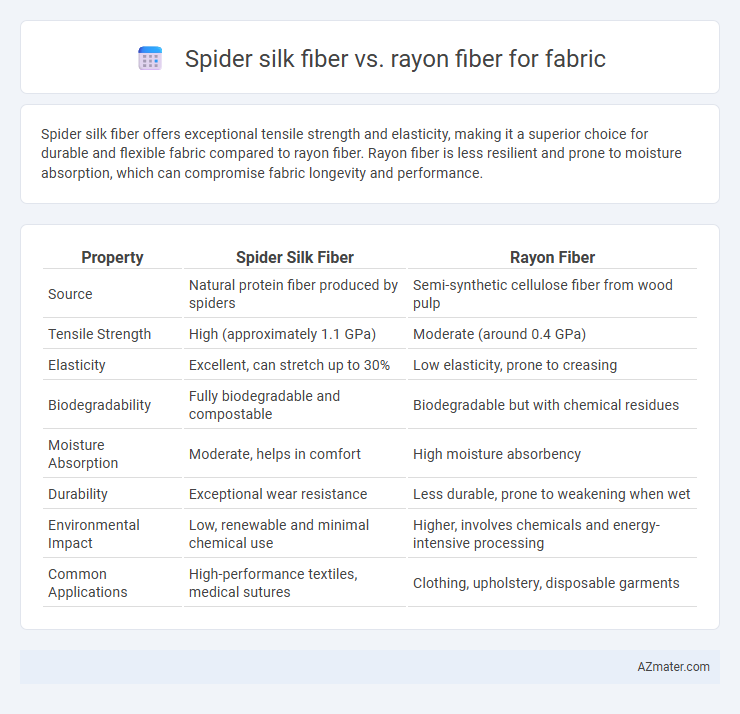Spider silk fiber offers exceptional tensile strength and elasticity, making it a superior choice for durable and flexible fabric compared to rayon fiber. Rayon fiber is less resilient and prone to moisture absorption, which can compromise fabric longevity and performance.
Table of Comparison
| Property | Spider Silk Fiber | Rayon Fiber |
|---|---|---|
| Source | Natural protein fiber produced by spiders | Semi-synthetic cellulose fiber from wood pulp |
| Tensile Strength | High (approximately 1.1 GPa) | Moderate (around 0.4 GPa) |
| Elasticity | Excellent, can stretch up to 30% | Low elasticity, prone to creasing |
| Biodegradability | Fully biodegradable and compostable | Biodegradable but with chemical residues |
| Moisture Absorption | Moderate, helps in comfort | High moisture absorbency |
| Durability | Exceptional wear resistance | Less durable, prone to weakening when wet |
| Environmental Impact | Low, renewable and minimal chemical use | Higher, involves chemicals and energy-intensive processing |
| Common Applications | High-performance textiles, medical sutures | Clothing, upholstery, disposable garments |
Introduction to Spider Silk and Rayon Fibers
Spider silk fiber, known for its exceptional tensile strength and elasticity, is a natural protein fiber produced by spiders that offers lightweight durability and biodegradability, making it highly valuable in advanced textile applications. Rayon fiber, a semi-synthetic material derived from regenerated cellulose, mimics the softness and drape of natural fibers such as cotton and silk while providing breathable and absorbent qualities. Both fibers serve diverse roles in fabric production, with spider silk excelling in performance textiles and rayon favored for versatile, cost-effective apparel.
Origin and Production Methods
Spider silk fiber originates from the natural protein secreted by spiders, harvested through a labor-intensive process involving the careful extraction of silk from spider silk glands or by encouraging spiders to spin silk on collection frames. Rayon fiber, on the other hand, is a semi-synthetic fiber derived from cellulose found in wood pulp, produced through a chemical process that dissolves cellulose into a viscous solution and regenerates it into fibers via spinning. The production of spider silk is limited and costly due to low yield and spider territorial behavior, whereas rayon manufacturing is industrialized at scale, involving chemical treatment and regeneration techniques that allow for mass production of fabric.
Physical Properties Comparison
Spider silk fiber exhibits exceptional tensile strength and elasticity, outperforming rayon fiber which tends to have lower durability and flexibility. The natural protein structure of spider silk contributes to its lightweight yet highly resilient characteristics, while rayon, a semi-synthetic fiber, demonstrates moderate moisture absorbency and weaker abrasion resistance. These contrasting physical properties make spider silk ideal for high-performance, durable fabrics, compared to rayon's suitability for softer, less demanding textile applications.
Strength and Durability Differences
Spider silk fiber exhibits exceptional tensile strength, often surpassing steel by weight, making it a highly durable option for fabric applications. Rayon fiber, derived from cellulose, has moderate strength but tends to weaken when wet and shows lower resistance to abrasion compared to spider silk. The superior molecular structure of spider silk contributes to its remarkable elasticity and long-lasting durability, setting it apart from rayon in strength and lifespan.
Flexibility and Elasticity Analysis
Spider silk fiber exhibits superior flexibility and elasticity compared to rayon fiber, enabling fabrics to stretch and recover without deformation. Spider silk's molecular structure, composed of highly organized protein chains, contributes to its exceptional tensile strength and resilience. Rayon fiber, derived from cellulose, offers moderate flexibility but lacks the high elasticity and recovery rate characteristic of spider silk, making spider silk fabrics preferable for applications requiring durability and stretchability.
Breathability and Moisture Management
Spider silk fiber exhibits superior breathability and moisture management compared to rayon fiber, as its natural protein structure allows for efficient air circulation and moisture-wicking properties. Rayon, a semi-synthetic fiber made from cellulose, tends to absorb moisture but dries slower, which can reduce comfort in high humidity conditions. The enhanced breathability of spider silk contributes to temperature regulation and faster evaporation, making it ideal for performance fabrics and activewear.
Environmental Impact and Sustainability
Spider silk fiber offers exceptional biodegradability and requires minimal water and chemical inputs during production, significantly reducing environmental pollution compared to rayon fiber, which is derived from wood pulp and often involves intensive chemical processing and deforestation. Rayon production contributes to habitat loss and generates toxic effluents, whereas spider silk cultivation can be engineered through sustainable bio-farming techniques with a smaller carbon footprint. Spider silk's renewable and biodegradable nature positions it as a highly sustainable alternative to rayon, supporting eco-friendly fabric innovation.
Comfort and Wearability
Spider silk fiber offers exceptional comfort and breathability due to its lightweight, smooth texture, and natural moisture-wicking properties, making it ideal for sensitive skin. Rayon fiber, while also soft and breathable, tends to absorb moisture less efficiently and may cause discomfort in high humidity or prolonged wear. In terms of wearability, spider silk provides superior elasticity and durability, maintaining shape and strength better over time compared to rayon's tendency to wrinkle and weaken with repeated washing.
Cost and Commercial Availability
Spider silk fiber offers superior strength and elasticity compared to rayon fiber but is significantly more expensive due to complex harvesting and production processes. Rayon fiber is widely available commercially and cost-effective, making it a preferred choice for mass-produced fabrics despite its lower durability. The high cost and limited commercial availability of spider silk currently restrict its use to specialized applications rather than mainstream fabric production.
Future Prospects in Textile Industry
Spider silk fiber offers exceptional tensile strength, biodegradability, and elasticity, making it a groundbreaking material for sustainable and high-performance textiles. Rayon fiber, derived from cellulose, remains widely used for its affordability and versatility but faces growing scrutiny over environmental impact. Future prospects in the textile industry favor spider silk for luxury, sportswear, and medical applications due to its advanced mechanical properties and eco-friendly production potential.

Infographic: Spider silk fiber vs Rayon fiber for Fabric
 azmater.com
azmater.com